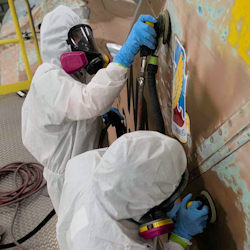Respiratory Protection
Note: As stated in OSHA Standard 1915.154 - Respiratory protection for shipyard employment is covered by OSHA Standard 1910.134 and OSHA Standard 1910.1025(f), Lead
A respirator is a device that protects you from inhaling dangerous substances, such as chemicals and infectious particles. The use of respirators is the least preferred method of controlling worker exposure to lead and should not normally be used as the only means of preventing or minimizing exposure during routine operations.
Selecting the right respirator requires an assessment of all the workplace operations, processes or environments that may create a respiratory hazard. The identity of the hazard and its airborne concentrations need to be determined before choosing a respirator. This assessment should be done by experienced safety personnel or by an industrial hygienist.
Respirators work by:
- filtering particles from the air,
- chemically cleaning (purifying) the air, or
- supplying clean air from an outside source.
The primary hazard from mechanical paint removal in a confined space is the generation and inhalation of dust and toxic particulates, especially if the paint contains hazardous substances like lead, asbestos, or other harmful chemicals. Hazards include:
- heavy metal dust including lead, arsenic, cadmium, chrome, beryllium; and silica
- dry ice (C02) when used as blast media;
- toxic fumes produced by flame removal of paint.
Knowledge Check Choose the best answer for the question.
3-1. The primary hazard from mechanical paint removal in a confined space is _____.
You forgot to answer the question!

